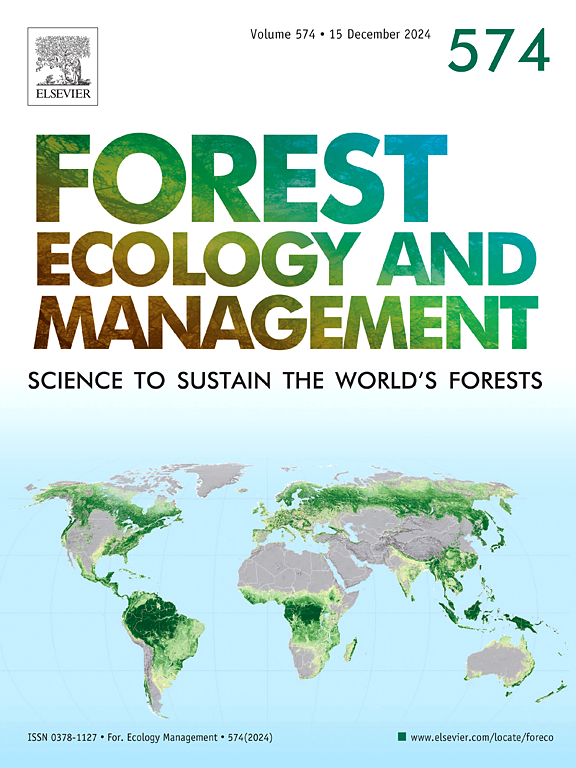橡实评论:树木如何应对古老的土壤?
IF 3.7
2区 农林科学
Q1 FORESTRY
引用次数: 0
摘要
森林的生长取决于从土壤中获取养分的途径,每种养分元素的投入、循环和损失率都不同。在任何年龄的土壤中,大多数森林土壤中某些养分的供应太低,无法维持最大的生长速度。有几种元素的供应依赖于地质母物质矿物中所含原子的再循环。即使是非常缓慢的年损失率也会导致数千年的大量枯竭,这使人们期望古代土壤的养分供应和生长速度应该非常低。这种期望与大多数古代土壤的现实不符,因为有几个特征结合在一起维持了土壤的生长。潮湿地区的古代土壤很深,根系有机会利用大量的土壤物质和储存的水。一些从地质母物质中耗尽的元素通过空气中的尘埃得到补充;在很长一段时间内,极低的投入率可能是相当可观的。植物和相关的微生物已经进化出从浓度极低的水池中获取营养物质的能力,并且从相对不溶的形式中获取营养物质。当地土壤的生物地球化学总是影响生长速度,简单地期望古代土壤生长不良是没有根据的。本文章由计算机程序翻译,如有差异,请以英文原文为准。
Acorn review: How do trees cope with ancient soils?
Growth of forests depends on access to nutrients from soils, with each nutrient element exhibiting different rates of inputs, cycling, and losses. Supplies of some nutrients are too low in most forest soils to support maximum growth rates, on soils of any age. The supplies of several elements depend on recycling of atoms contained in minerals of the geological parent material. Even very slow annual rates of loss can lead to substantial depletion over millennia, raising an expectation that ancient soils ought to have very low nutrient supplies and low rates of growth. This expectation does not match the reality of most ancient soils because several features combine to sustain growth. Ancient soils in humid regions are deep, with opportunities for roots to exploit very large volumes and masses of soil materials and supplies of stored water. Some elements that are depleted from geologic parent material are replenished via air-borne dust; very low rates of input can be substantial over very long periods. Plants and associated microbes have evolved abilities to access nutrients from pools at very low concentrations, and from relatively insoluble forms. Local biogeochemistry of soils always influences growth rates, and simple expectations of poor growth on ancient soils are unwarranted.
求助全文
通过发布文献求助,成功后即可免费获取论文全文。
去求助
来源期刊

Forest Ecology and Management
农林科学-林学
CiteScore
7.50
自引率
10.80%
发文量
665
审稿时长
39 days
期刊介绍:
Forest Ecology and Management publishes scientific articles linking forest ecology with forest management, focusing on the application of biological, ecological and social knowledge to the management and conservation of plantations and natural forests. The scope of the journal includes all forest ecosystems of the world.
A peer-review process ensures the quality and international interest of the manuscripts accepted for publication. The journal encourages communication between scientists in disparate fields who share a common interest in ecology and forest management, bridging the gap between research workers and forest managers.
We encourage submission of papers that will have the strongest interest and value to the Journal''s international readership. Some key features of papers with strong interest include:
1. Clear connections between the ecology and management of forests;
2. Novel ideas or approaches to important challenges in forest ecology and management;
3. Studies that address a population of interest beyond the scale of single research sites, Three key points in the design of forest experiments, Forest Ecology and Management 255 (2008) 2022-2023);
4. Review Articles on timely, important topics. Authors are welcome to contact one of the editors to discuss the suitability of a potential review manuscript.
The Journal encourages proposals for special issues examining important areas of forest ecology and management. Potential guest editors should contact any of the Editors to begin discussions about topics, potential papers, and other details.
 求助内容:
求助内容: 应助结果提醒方式:
应助结果提醒方式:


